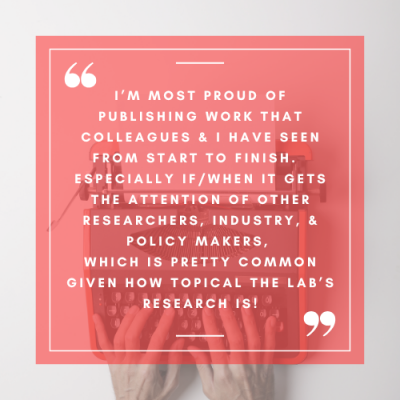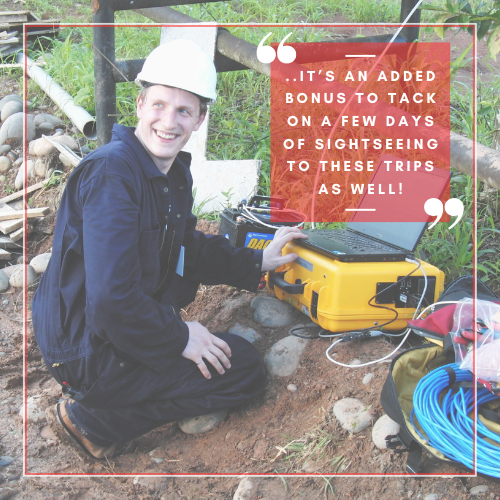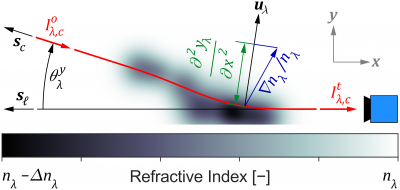Meet one of our superstar researchers – Dr. Bradley Conrad!
Brad joined EERL (Energy & Emissions Research Lab) after finishing his undergraduate program in Mechanical Engineering at Carleton ten years ago. Having received an NSERC USRA (undergraduate student research award) he started off as a summer student and continued as a Master’s student in the fall of 2013.
 Fast-forward 10 years and Brad is now a research associate with our lab. He studied black carbon emissions from gas flaring by refining the sky-LOSA optical measurement technique during his Ph.D. More recently he has been working on aerial detection of methane emissions in the Canadian upstream oil and gas sector, including the development and application of robust methods to characterise aerial methane detection technologies and derive provincial methane emissions inventories from aerial surveys with comprehensive consideration of uncertainties. He is an accomplished researcher, and his work has been published and featured in high-impact international journals over the years.
Fast-forward 10 years and Brad is now a research associate with our lab. He studied black carbon emissions from gas flaring by refining the sky-LOSA optical measurement technique during his Ph.D. More recently he has been working on aerial detection of methane emissions in the Canadian upstream oil and gas sector, including the development and application of robust methods to characterise aerial methane detection technologies and derive provincial methane emissions inventories from aerial surveys with comprehensive consideration of uncertainties. He is an accomplished researcher, and his work has been published and featured in high-impact international journals over the years.
Behind any accomplishment there are often challenges, learning curves and a fair bit of problem-solving. Brad has always reached out to senior colleagues to gain perspective and get their thoughts on potential solutions. This collegial approach was not only useful in tackling issues but also allowed him to connect more with the lab team and colleagues in the department (and saved time and headache!) during his graduate studies. Brad’s advice is to never hesitate in reaching out to others to brainstorm ideas and talk about challenges you might be facing.
 One of his highlights at EERL is travel (mostly pre-COVID); there are plenty of travel opportunities for field trips and conferences. For Brad it’s a fulfilling process of planning, organising and successfully executing complex measurement campaigns, and presenting results to other researchers that are genuinely interested in the team’s hard work. During his time at EERL he performed field measurements in western Canada, Mexico, and Ecuador and presented at conferences across North America and Europe.
One of his highlights at EERL is travel (mostly pre-COVID); there are plenty of travel opportunities for field trips and conferences. For Brad it’s a fulfilling process of planning, organising and successfully executing complex measurement campaigns, and presenting results to other researchers that are genuinely interested in the team’s hard work. During his time at EERL he performed field measurements in western Canada, Mexico, and Ecuador and presented at conferences across North America and Europe.
When asked about a favourite quote or saying, Brad suggested that he is more likely to have a favourite equation! Although it hasn’t come up since his Ph.D. research, the principle of least action neatly describes (among many other things) how light travels through a turbulent plume of heated gas, which can cause blur in imagery used to detect emissions.

 When not appreciating equations, crunching numbers, writing papers, or measuring methane emissions, Brad can be found cooking up a delicious meal with his wife, doing yard work, snowshoeing or hiking. “There’s nothing like a crisp fall-time hike with a Macintosh apple or two!”
When not appreciating equations, crunching numbers, writing papers, or measuring methane emissions, Brad can be found cooking up a delicious meal with his wife, doing yard work, snowshoeing or hiking. “There’s nothing like a crisp fall-time hike with a Macintosh apple or two!”
Despite routinely reading for work, he loves reading during his spare time as well. He is currently in a Scandinavian suspense phase reading Hidden in Snow by Viveca Sten and “not-so-patiently awaiting” Lars Kepler’s new Joona Linna book.
Finally, if Brad’s story inspired you to join EERL here is his piece of advice to anyone joining our team: